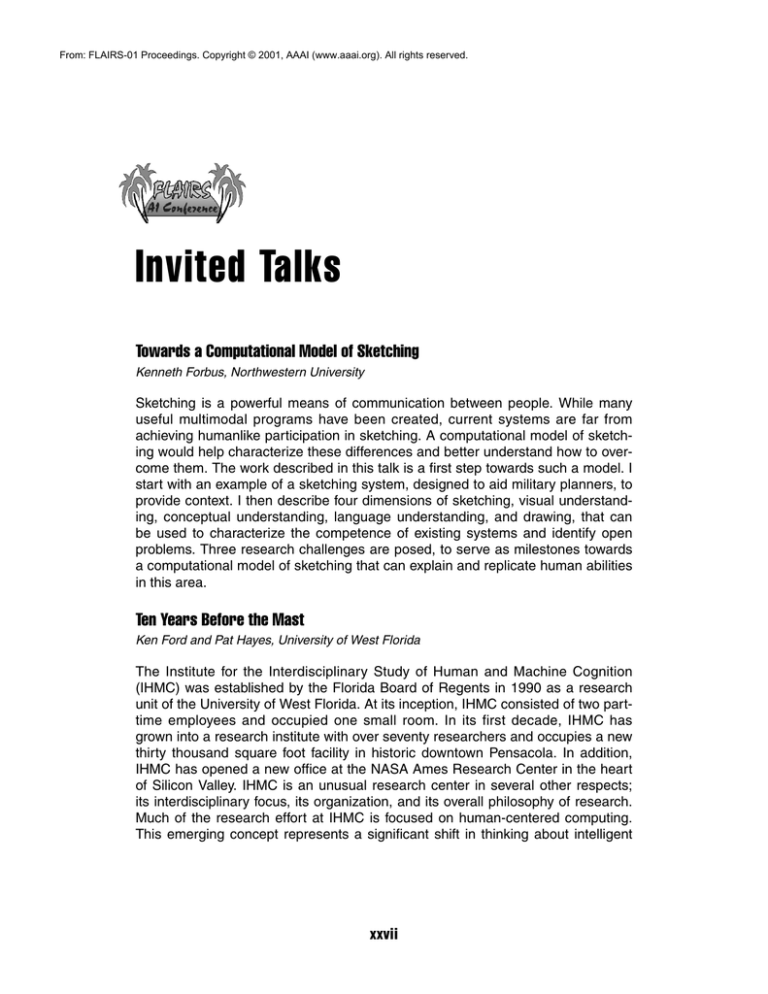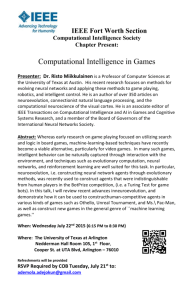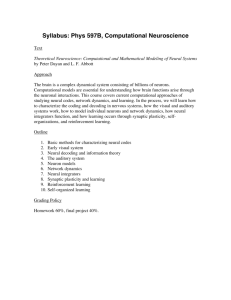
From: FLAIRS-01 Proceedings. Copyright © 2001, AAAI (www.aaai.org). All rights reserved.
Invited Talks
Towards a Computational Model of Sketching
Kenneth Forbus, Northwestern University
Sketching is a powerful means of communication between people. While many
useful multimodal programs have been created, current systems are far from
achieving humanlike participation in sketching. A computational model of sketching would help characterize these differences and better understand how to overcome them. The work described in this talk is a first step towards such a model. I
start with an example of a sketching system, designed to aid military planners, to
provide context. I then describe four dimensions of sketching, visual understanding, conceptual understanding, language understanding, and drawing, that can
be used to characterize the competence of existing systems and identify open
problems. Three research challenges are posed, to serve as milestones towards
a computational model of sketching that can explain and replicate human abilities
in this area.
Ten Years Before the Mast
Ken Ford and Pat Hayes, University of West Florida
The Institute for the Interdisciplinary Study of Human and Machine Cognition
(IHMC) was established by the Florida Board of Regents in 1990 as a research
unit of the University of West Florida. At its inception, IHMC consisted of two parttime employees and occupied one small room. In its first decade, IHMC has
grown into a research institute with over seventy researchers and occupies a new
thirty thousand square foot facility in historic downtown Pensacola. In addition,
IHMC has opened a new office at the NASA Ames Research Center in the heart
of Silicon Valley. IHMC is an unusual research center in several other respects;
its interdisciplinary focus, its organization, and its overall philosophy of research.
Much of the research effort at IHMC is focused on human-centered computing.
This emerging concept represents a significant shift in thinking about intelligent
xxvii
machines, and indeed about information technology in general. It embodies a
“systems view,” in which human thought and action and technological systems
are seen as inextricably linked and equally important aspects of analysis, design,
and evaluation. As in traditional AI, we are trying to make machines smarter; but
rather than imitating people, or setting our machines in some kind of race against
human talents, the goal is to amplify human cognitive abilities by designing cognitive prostheses, computational systems that leverage and extend human intellectual capacities, just as the steam-shovel was a sort of muscular prosthesis. The
design and fit of computational prostheses require a broader interdisciplinary
range than has traditionally been associated with AI work, and IHMC staff includes computer scientists, cognitive psychologists, neuroscientists, physicians,
educationalists, philosophers, engineers and social scientists of various stripes,
as well as some people who resist all attempts to classify them.
Morphological Neural Networks
Gerhard X. Ritter, University of Florida
The theory of artificial neural networks has been successfully applied to a wide
variety of pattern recognition problems. In this theory, the first step in computing
the next state of a neuron or in performing the next layer neural network computation involves the linear operation of multiplying neural values by their synaptic
strengths and adding the results. Thresholding usually follows the linear operation in order to provide for nonlinearity of the network. In this talk I introduce a
novel class of neural networks, called morphological neural networks, in which
the operations of multiplication and addition are replaced by addition and maximum (or minimum), respectively. By taking the maximum (or minimum) or sums
instead of the sum of products, morphological network computation is nonlinear
before thresholding. As a consequence, the properties of morphological neural
networks are drastically different than those of traditional neural network models.
In this talk I consider some of these differences and provide some particular examples of morphological neural network.
Didn’t Samuel Solve that Game?
Jonathan Schaeffer, University of Alberta
Arthur Samuel’s pioneering machine learning papers are classics. Yet he is best
remembered for his checkers-playing program. In 1963, his program defeated a
human opponent in a single game, a milestone for the fledgling field of artificial
intelligence. Since that historic encounter, checkers has been branded as a
“solved” game. As a result, checkers was passed over in favor of using chess as
an experimental test bed for artificial intelligence research.
The 1963 game was an abberration. In 1994, the program Chinook became the
official World Man-Machine Checkers Champion, finally realizing Samuel’s
xxviii
dream. Along the way, there was an imposing obstacle to overcome: the unbeatable human World Champion, Dr. Marion Tinsley. And thus begins our story….
Although initially begun as a research project, the Chinook effort soon changed
directions and became a quest to defeat Tinsley. Instead of an impersonal contest between a man and a machine, it became a personal battle between two humans striving for supremacy at checkers. In this talk, the creator of Chinook presents the personal and technical sides of man versus machine for the World
Checkers Championship.
xxix







